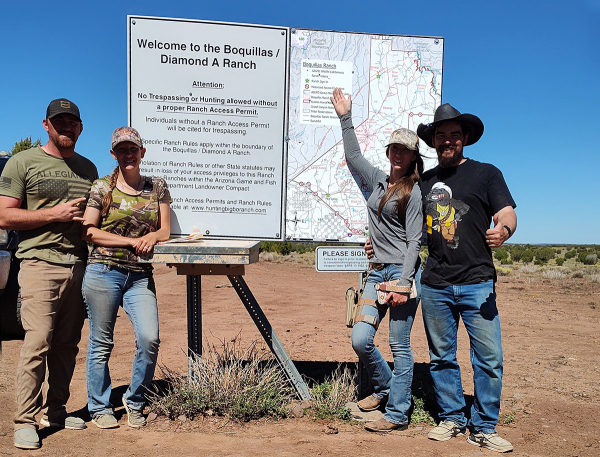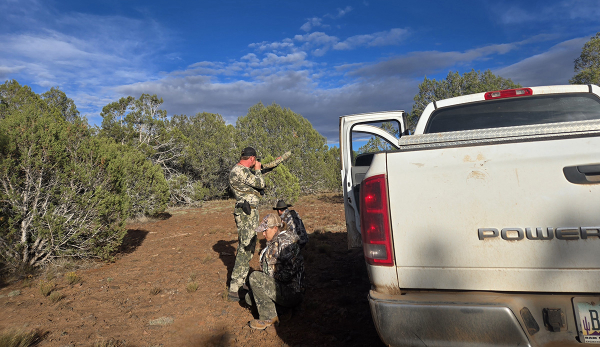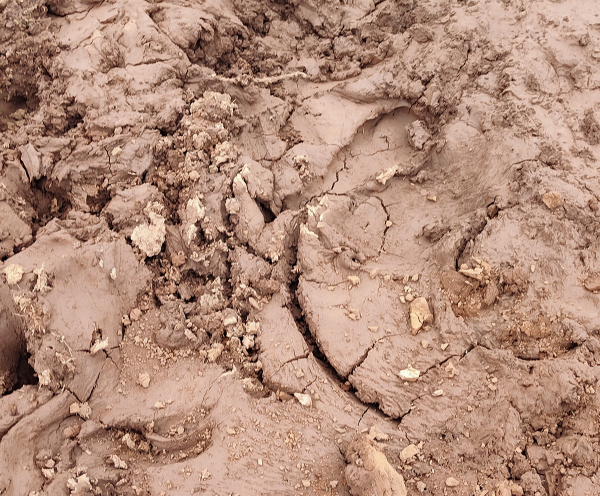Today we bring you part two of Lacey Polacek’s first elk hunt in one of Arizona’s premier hunting units. You can read the first installment, Arizona Elk, Part One: The Prep, from Monday’s edition of The Outdoor Wire. We want to thank Lacey for taking the time to share another of her hunting adventures with our readers.

Entering the hunting scene seriously in my early twenties, I was always awe-struck—and admittedly intimidated—by the idea of hunting Rocky Mountain elk. It’s widely recognized as one of the hardest, most demanding pursuits of a hunter’s career. Elk go places no person ever wants to but somehow always manage to thrive. They are majestic beyond measure, powerful, and downright tough.
If you’re lucky enough to hunt them during the rut, you’ll find yourself somewhere magical. It was there, on my first elk hunt, that I witnessed a true miracle.
Paired with my husband and two best friends, we ventured into Arizona’s premium Unit 10 with a bull elk tag in my pocket. It was late September, and we were already nervous about the heat and the lack of rain.

Our first day was spent glassing the open prairies. All morning we stared at empty hills and pockets, our only notable sighting a small squadron of javelina. After lunch, we drove through a few other areas recommended by friends and family.
Day One: no sight, no sound. We retreated to a campfire and a pouch of Mountain House for dinner.
At first light the next morning, we hiked into a lesser-known—and never-mentioned—water tank. Fresh wallows, tracks, and that unmistakable musky scent told us bull elk were close.

Letting our presence be known, an artificial bugle cut through the still morning air. Within seconds, three bulls bugled back. Finally. One to our left and one or two to our right, about a mile away. Chambering a 28 Nosler round, I threw on my pack and hoofed it to the right.
After a half-mile push, we bugled again to relocate. A response—they were still there. We slowed our pace. Another 500 yards, another bugle. This time, a bull responded from behind a single bush. My heart stopped. I dropped to the ground, steadying my rifle on a flimsy branch while my two friends fell back 20 yards to call him in closer.
An estrus cow call cut the air, then silence. We sidestepped around the brush and caught a fleeting glimpse of a few cows and a magnificent bull bringing up the rear. Defeated again, but now exhilarated—I’d had my first close encounter. The hardest part, finding them, was done.
As we whispered plans for the next move, a sudden crash broke the quiet. Fifty yards below, a bigger, silent bull exploded from cover—a thick, tall 6x6 following the herd. Lesson one, check.
There wasn’t much to plan—I knew I wanted to return the next morning. Not wanting to pressure the herd, we left the area and killed time driving, stopping, bugling, and listening. By nightfall we had sore feet and empty lungs.
Not even Mountain House and a campfire could keep me still. I was hooked. Chasing bugles had become my new favorite pastime.
After just four hours of sleep, we were back at it—tired but determined, breakfast burritos in hand. Thick fog socked us in as we returned to the same tank. Our bugles were met with silence. Still, I was convinced they were near; the signs from yesterday said they’d been living there for days.
After several fruitless attempts, we decided to move. Maybe on the other side of the ridge, we’d find a break in the fog—and in our luck.
Continuing down the main drag, we approached the mountain separating us from the tank. My group had the same thought I did—they had to be nearby.
We pulled over to bugle one last time before leaving the area for good. The sun barely cut through the fog as our call echoed. Then—six bugles answered at once. They were less than a mile away.
I slung my rifle, chambered a round, dropped my pack, and we charged through the brush. Visibility was no more than 20 yards, but the bulls’ bellows drew us onward. Every hundred yards we’d stop and listen; their calls never stopped, but never seemed closer. We were chasing them, not catching them.
After what felt like miles, the forest went silent. They’d gone—back over the mountain toward the tank. We were disappointed, but now we had their pattern: they stayed in this area overnight and moved toward water at dawn. With the wind shifting against us, we’d save our plan for tomorrow.
Day Four: I woke up with something new—confidence.
The thick fog returned, blanketing the brush as we moved through it, silent and careful. I carried only my rifle this time, determined not to make a sound. We had a mile to hike before reaching the bowl, our boots muffled by the damp ground.
The stillness was unnerving. Are they here? Doubt crept in as we neared the ridge from two days earlier. About 100 yards out, we stopped to listen.
Then—one bugle, then another, then three more. Fifty yards away, the herd erupted. We were in the middle of them. Satellite bulls screamed from every direction.
I barely had a moment to take it in before my husband whispered urgently—we had to move and set up. They’d be on the hill any second. One to our left was 30 yards away and closing fast. I found a small opening that gave me a visual lane. Instinct guided every move. With bulls converging from both sides, they’d have to meet right here to win their harem.
Shaking, I waited. My friends crouched beside me, watching. The base of the hill was just 40 yards away—an easy shot, I thought.
A deep grunt followed by a breathy bugle came from my left. I heard his breath—he was steps away. At 38 yards he filled my scope, his shoulder blotting out everything else. I raised my rifle slightly—one, two, three, four, five, six points. Bang!
I loaded another round instantly and waited. He reared, turned, and trotted off. The shot felt solid. It had to be.
I let him move to die, adrenaline surging until I sat down, shivering, while my friends stayed locked on the hillside. We waited 30 minutes for the fog to clear enough to see across the bowl. No movement. The forest was silent.
When we finally stood, the quiet broke—elk still lingered below. Crashing through the trees, they vanished over the far ridge. I caught sight of one bull limping heavily. He looked exactly like the one I’d just shot. Convinced they were related, I pushed downhill to look for blood. Aside from a drop or two, there was none. That was my bull—and I’d just let him get away.
We ran back up the hill, scouring every slope in desperation. I knew he was hurt and close—I could hear faint grunts and thrashing. The jack pines were dense, the mist lifting just enough to tease visibility but never clarity.
Two hours later, I found him. Between two trees skirted by jack pines lay the silhouette of a bull—300 yards across the ridge.
I had two choices: stalk closer or shoot from here. He was quartering away, shielded by branches. The only opening to his vitals was four or five inches wide. A tough shot. But stalking meant failure; he was too alert. I waited, prayed, then decided—I’d take it. My longest shot yet.

As I settled into position, the bull rose as if he knew. I clicked off the safety, centered the crosshairs on his vitals, and squeezed. Bang.
I closed my eyes, bracing for someone to tell me he’d vanished. Instead, I heard, “Dropped him!” “He’s down!”
At 300 yards, I’d threaded a bullet perfectly through the brush, breaking both shoulders. He collapsed where he stood—dead instantly. My second adrenaline rush hit hard, leaving me trembling and nauseous. We did it.

My first bull elk. My first kill that almost got away. My longest shot. A new addiction—and a lifetime of memories.
Arizona Unit 10, I’ll never stop putting in for you.
— Lacey Polacek
Lacey Polacek is an avid hunter from wingshooting to big game and anything inbetween. She has worked at Wolfe Publishing Company as a Graphic Designer for Rifle magazine and Varmint magazine since 2018. Her career aligns with her hobbies of design, photography, shooting and the outdoors.